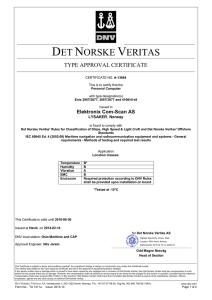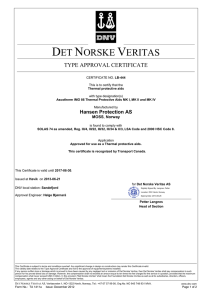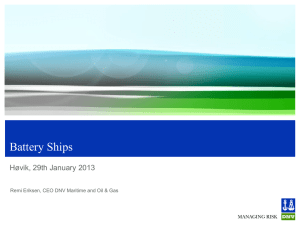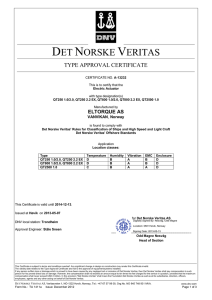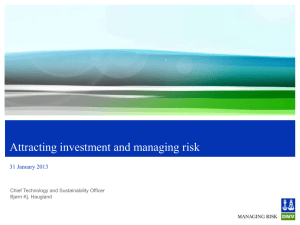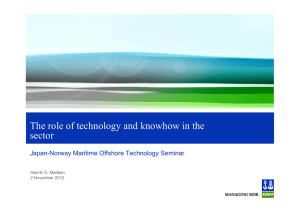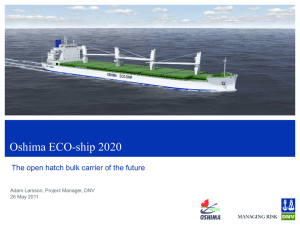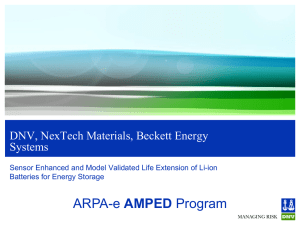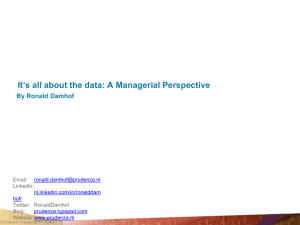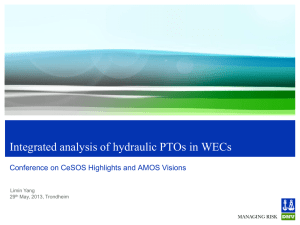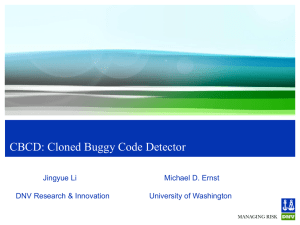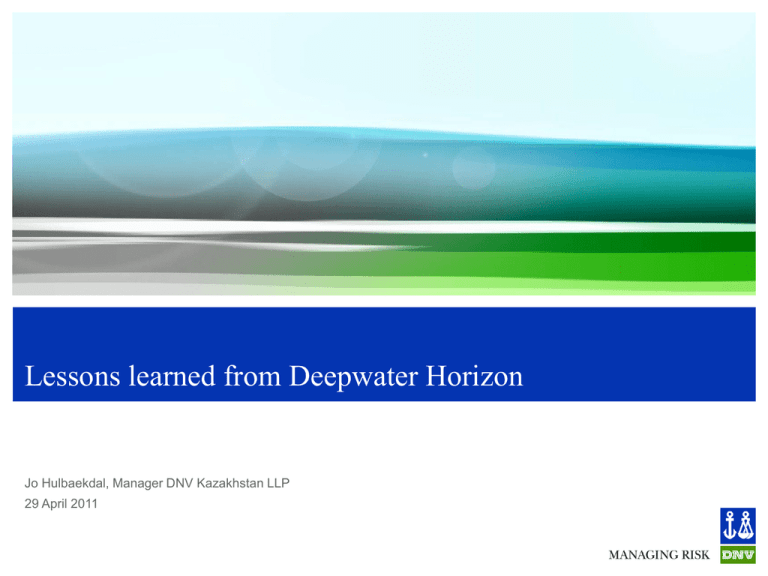
Lessons learned from Deepwater Horizon
Jo Hulbaekdal, Manager DNV Kazakhstan LLP
29 April 2011
Presentation outline
The Deepwater
Horizon, a gamechanger?
DNV’s involvement
and response
A new US
regulatory regime?
Industry changes?
Tuesday, 26 April 2011
© Det Norske Veritas AS. All rights reserved.
2
The event: April 20th, 2010
About 21:40 local time, gas under high
pressure flows uncontrolled up from the
Macondo well onto Deepwater Horizon. The
gas ignites resulting in fires and explosions.
DWH sank 36 hours later.
11 fatalities and 17 injured
Oil leakage:
- From April 20th – July 15th (well capped)
- Initial rate 62,000 b/d declining to 53,000 b/d
(750.000 tonnes in total)
Twice as big as the largest oil spill event
ever
Tuesday, 26 April 2011
© Det Norske Veritas AS. All rights reserved.
3
Industry response: Immediate uncertainties
Will liability and insurance premiums increase?
Will result of investigation lead to redesign of BOP stacks?
How will the new US regulatory regime and legislation affect cost?
How will this influence the drilling activity, the rig market and the
competitive situation in US?
How will changes in the US affect offshore activities elsewhere?
Tuesday, 26 April 2011
© Det Norske Veritas AS. All rights reserved.
4
Major accidents have consequences on regulations
NEW REGULATORY
REQUIREMENTS
Alexander Kielland (1980) – structural
redundancy, risk acceptance criteria
Piper Alpha (1988) – “Safety Case”,
risk management approach
Exxon Valdez (1989) – double hull
tankers
Texas City (2005) – increased safety
for process industry
MACONDO BLOWOUT ???
Tuesday, 26 April 2011
© Det Norske Veritas AS. All rights reserved.
5
DNV’s involvement and
response
Tuesday, 26 April 2011
© Det Norske Veritas AS. All rights reserved.
6
To kill the Macondo blow-out was a complex marine operation:
Managing risk is crucial
DNV involvement:
Hazid facilitation for BP
Verification of marine risers
Safety Case Studies for rigs
Re-certification of BOP systems
Topside verification,
assessment of marine systems,
stability inspections of involved
vessels
Review of the DWH
maintenance system and rig
condition assessment program
Safety and flaring studies
Tuesday, 26 April 2011
© Det Norske Veritas AS. All rights reserved.
7
US-Norway, share industry learning
Tuesday, 26 April 2011
© Det Norske Veritas AS. All rights reserved.
8
Investigation of BOP for US Government
The Joint Investigation Team (JIT) of the
departments of the Interior and Homeland
Security has contracted DNV for the
forensic examination of the blowout
preventer and lower marine riser package
that was fitted to the Macondo well
16 meter tall, weight 300 tonnes
Forensic investigation use expertise from:
- Technology Centre, Columbus
- Deepwater Technology Centre in Houston
Report published March 23rd, 2011
Tuesday, 26 April 2011
© Det Norske Veritas AS. All rights reserved.
9
A new US regulatory regime?
Tuesday, 26 April 2011
© Det Norske Veritas AS. All rights reserved.
10
Comparing the US and Norwegian offshore drilling regulations:
Key regulatory regime differences
The Norwegian regulations are mainly performance-based
The U.S. regulations are primarily prescriptive
The intention with a performance-based regime is to make the operator regulate
own activity when it comes to safety, health and environment (SHE)
The intention with prescriptive regulations is to prevent accidents by identifying
specific technical requirements that the operator must comply with. The
Authorities control the operator’s activity inter alia through approvals and
inspections.
Tuesday, 26 April 2011
© Det Norske Veritas AS. All rights reserved.
11
Comparing the US and Norwegian offshore drilling regulations:
Key learning points
Mainly risk-based approach, systematically identify and mitigate risks.
Separate authorities for resource management and SHE management
Agency with coordinating role in the development and supervision of SHE
regulations.
Establish barriers on technical, operational and organisational levels
Latest edition of applicable regulations and referred standards for mobile units
Two independent and tested well barriers in all drilling and well operations
Recertification of blow-out-preventer (BOP) every 5 years
AND one area where we are not so different
Validation of functionality and capacity of oil recovery equipment ?
Tuesday, 26 April 2011
© Det Norske Veritas AS. All rights reserved.
12
Presidential Commission Report, Jan 11th 2011:
Selected recommendations
Significantly increase the liability cap and financial
responsibility requirements for offshore facilities.
Establish independent offshore safety agency.
Develop a proactive, risk-based performance approach
similar to the “safety case” approach in the North Sea.
Supplement the risk-management program with
prescriptive safety and pollution-prevention standards.
Industry “best practice” standards should be applied and
updated in the Gulf of Mexico, in the Arctic, and globally.
Create a rigorous, transparent, and meaningful oil spill
risk analysis and planning process for better oil spill
response.
Well components, including blowout preventer stacks,
are equipped with sensors or other tools to obtain
accurate diagnostic information—for example, regarding
pressures and the position of blowout preventer rams.
http://www.oilspillcommission.gov/final-report
Tuesday, 26 April 2011
© Det Norske Veritas AS. All rights reserved.
13
Industry changes?
Tuesday, 26 April 2011
© Det Norske Veritas AS. All rights reserved.
14
Consequences in the US Gulf of Mexico
The drilling moratorium was lifted on
October 12, 2010
- certify compliance with existing rules and
requirements, including those that recently
went into effect
- adequate blowout containment resources
- shallow water drilling operations subject to new
rules and requirements as of June 8, 2010.
New regulations and standards
- Environmental NTL (Notice to Lessees),
Compliance and Review NTL, Drilling Safety
Rule and the Workplace Safety Rule.
13 companies may resume their drilling
activities as of January 3, 2011
- provided they comply with new policies and
regulations set by BOEMRE
Tuesday, 26 April 2011
© Det Norske Veritas AS. All rights reserved.
15
Norway and UK:
Reactions
Norwegian and UK oil industries are reasonably
confident that their regulations are modern and
well functioning.
Norwegian Government and OLF have been
cooperating with the US authorities. Ditto UK
Government and HSE.
In both countries the regulatory authorities and
oil industry are however keen to extract key
learnings from the event.
Environmental concerns have risen higher on
the agenda, especially for the High North and
more sensitive areas, such as Lofoten.
Oil & Gas UK has established the Oil Spill
Prevention and Response Advisory Group
(OSPRAG) looking at UK oil spill response.
Both countries also watching EU developments.
Tuesday, 26 April 2011
© Det Norske Veritas AS. All rights reserved.
16
Rest of the world’s reaction - examples
Awaiting outcome of the US investigations
(UK, Norway, Canada, Brazil)
Greenland required Cairn Energy to have a
second rig on standby to drill a relief well
Australia reviewing their national oil spill
plans, current plans are for a tanker
grounding and not a long term blow out
Gabon have cancelled offshore acreage bid
rounds until US investigations are complete
A lot of understandable “wait and see”.
Tuesday, 26 April 2011
© Det Norske Veritas AS. All rights reserved.
17
Key take away
The Deepwater Horizon is a gamechanger
- we are facing a systematic shift with
significant reach
A new US regulatory regime is in the
making
- most likely with international impact
Industry changes will be significant
- Increasing the focus on safety,
environment and risk management
Tuesday, 26 April 2011
© Det Norske Veritas AS. All rights reserved.
18
Safeguarding life, property
and the environment
www.dnv.com
Tuesday, 26 April 2011
© Det Norske Veritas AS. All rights reserved.
19

